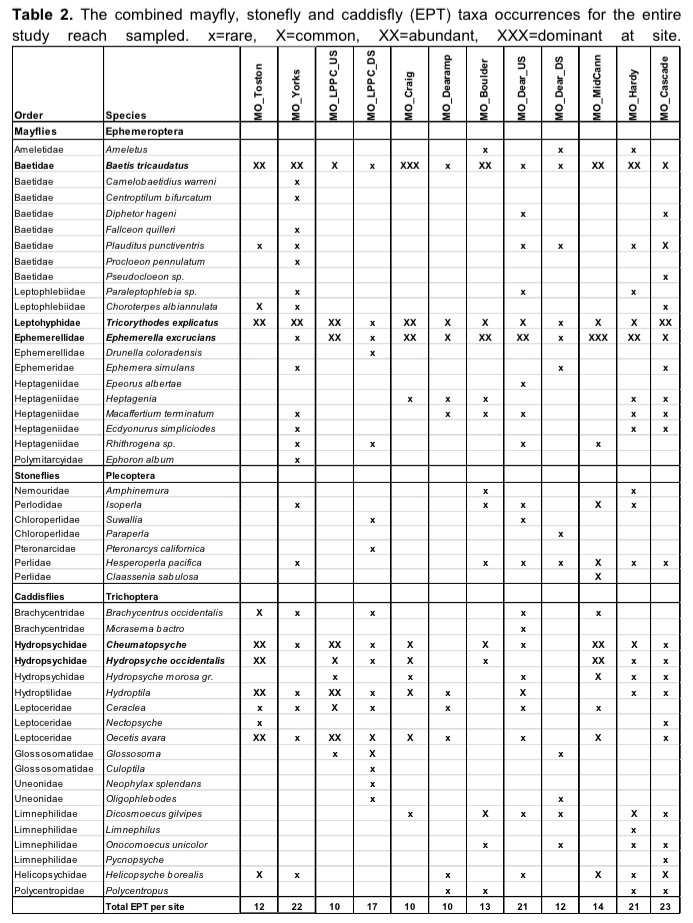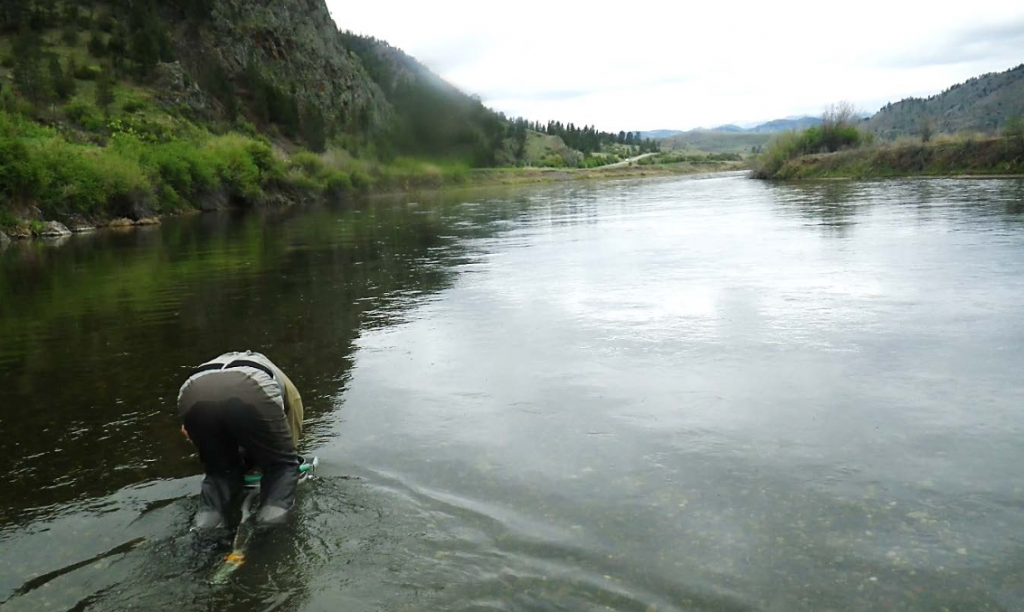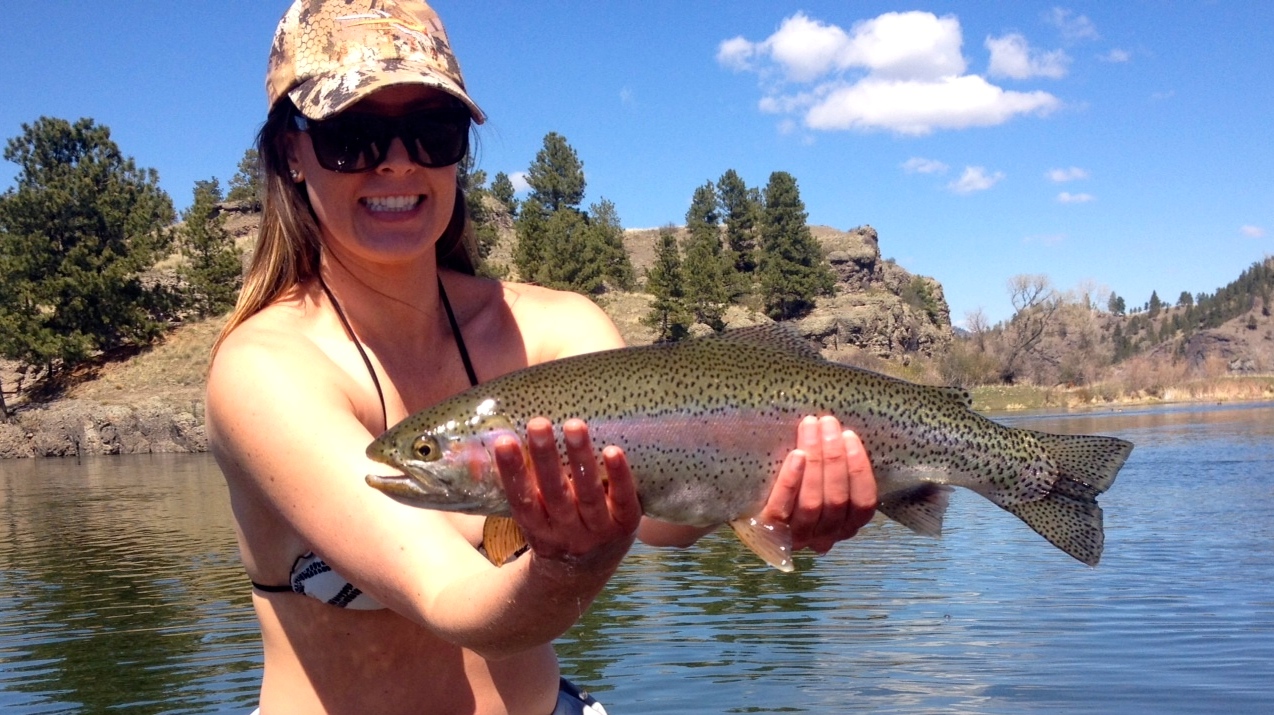On December 22, the Upper Missouri River Watershed Alliance (UMOWA) released the Baseline Macroinvertebrate Monitoring Report 2015 for the Upper Missouri River, MT, prepared by David Stagliano. The purpose of this study was to provide baseline macroinvertebrate (bug) monitoring data in order to assess the aquatic biointegrity, or health, of the Missouri River. This study is the most comprehensive study of its kind thus far performed on the Missouri River. In addition to the study’s conservation significance, it has yielded a lot of information that may be of interest to Missouri River anglers.
Study Findings:
Samples were collected at ten sites on the Missouri River between Holter Dam and Cascade, at one site near Toston, and at one site near York’s Island. A total of 93 different macroinvertebrate taxa were collected. Of these, 47 were mayflies, caddisflies, and stoneflies (EPT taxa) which are of particular interest to fly anglers. The other 46 taxa were midges or non-insect organisms like aquatic worms, scuds, sowbugs, or snails.
The overall density of bugs was greatest above the town of Craig with densities averaging 12,000 individuals per square meter. As distance below Holter Dam increased, there were generally fewer bugs, but a greater diversity of different taxa. In other words, there are more total bugs upstream but a greater number of different bugs downstream. Samples taken near Cascade had the greatest number of different taxa found at one site (47). On average, approximately 27 different taxa were observed at each site.
Mayflies:
There were 21 species of mayflies identified. The dominant three were BWO’s (Baetis tricaudatus), Tricos (Tricorythodes explicatus), and Pale Morning Duns (Ephemerella excrucians). The dominant mayfly at each site was determined by season and the amount of silt present in the river bottom. Trico proportions increased with silt presence whereas PMDs and Baetis generally preferred riffle habitats.
Caddisflies:
There were 19 species of caddisflies identified. The dominant caddis was the Little Sister Sedge (Cheumatopsyche) but other net-spinning caddis (Hydropsyche sp.), microcaddis (Hydroptila), snail-cased caddis (Helicopsyche borealis), and long-horned caddis (Oecetis sp.) were also common. The large orange October Caddis (Dicomoecus gilvipes) was found throughout the sample sites but most common below the Dearborn River.
Stoneflies:
There were 7 species of stoneflies identified. They were observed sporadically across the sample sites but their abundance and diversity was greatest at downstream sample sites. Stoneflies were also common around the mouths of Little Prickly Pear Creek and the Dearborn River. The stonefly species collected included Golden Stones (Hesperoperla pacifica and Claasenia sabulosa), Yellow Sallies (Suwallia/Paraperla), Spring Stones (Amphinemura), and Green-winged Stones (Isoperla). Even one Salmonfly (Pteronarcys californica) was observed below the mouth of Little Prickly Pear Creek.
Seasonal Trends:
The study showed a seasonal trend in the makeup of the aquatic communities. Following the spring runoff, the overall abundance of bugs directly downstream of both Little Prickly Pear Creek and the Dearborn River was very low. This was probably due to riverbed scouring by the high spring flows in these tributaries. By summer, mayflies and caddisflies were numerous at most of the sites. As hatches tapered off during the fall period, mayfly and caddis numbers dropped and non insect taxa such as sowbugs, scuds, worms, and snails made up a greater proportion of the aquatic community.
Comparison With Historical Data:
Prior to this study, the Montana Department of Environmental Quality (MDEQ) sampled several of the same sites during the mid-2000s. Compared to their study findings, caddis numbers have decreased during the last decade while midge and sowbug numbers have increased. This change may be due to increased sediment build up combined with aquatic vegetation trapping sediments.
As UMOWA continues to sample these sites each year, anglers will have a better idea how the macroinvertebrate community in the Missouri River is changing over time. This study will also help inform future river management decisions.
The table below shows all of the mayfly, caddisfly, and stonefly taxa that were observed for all the sample sites. LPPC site name refers to Little Prickly Pear Creek. Boulder site name refers to riprap bank above Dearborn River. US = upstream. DS = downstream.
- x = present but rare
- X = common
- XX = abundant
- XXX = dominant

The following figures illustrate the macroinvertebrate metric averages for all of the sample sites during all seasons (spring, summer, and fall). Errors bars are standard error (SE). Blue arrows indicate where Little Prickly Pear Creek (LPPC) and the Dearborn River enter the Missouri River. For the site names, US = upstream. DS = downstream.
EPT taxa = mayflies, caddisflies, and stoneflies.
Use the slider arrows to view each of the five graphs. If you would like to view these graphs in the context of the full report, click here.






4 Comments.
Nice!
Nice post Braden! I may be adjusting my fly selection a bit.
12,000 individuals per square meter?! That’s freaking insane and awesome. No wonder the tricos look like smoke sometimes.
Lots and lots of bugs are a big part of what makes the MO so great. Hopefully each of us anglers as well as groups like UMOWA can keep it that way for future generations to enjoy.